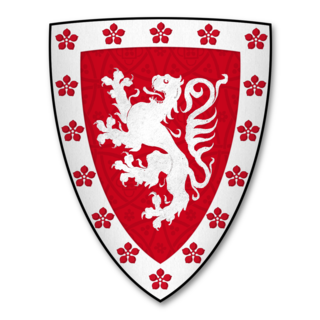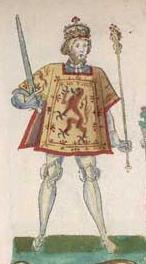
Perkin Warbeck was a pretender to the English throne claiming to be Richard of Shrewsbury, Duke of York, who was the second son of Edward IV and one of the so-called "Princes in the Tower". Richard, were he alive, would have been the rightful claimant to the throne, assuming that his elder brother Edward V was dead and that he was legitimate—a point that had been previously contested by his uncle, King Richard III.

James IV was King of Scotland from 11 June 1488 until his death at the Battle of Flodden in 1513. He inherited the throne at the age of fifteen on the death of his father, James III, at the Battle of Sauchieburn, following a rebellion in which the younger James was the figurehead of the rebels. James IV is generally regarded as the most successful of the Stewart monarchs. He was responsible for a major expansion of the Scottish royal navy, which included the founding of two royal dockyards and the acquisition or construction of 38 ships, including the Michael, the largest warship of its time.

Margaret Tudor was Queen of Scotland from 1503 until 1513 by marriage to King James IV. She then served as regent of Scotland during her son's minority, and fought to extend her regency. Margaret was the eldest daughter and second child of King Henry VII of England and Elizabeth of York, and the elder sister of King Henry VIII of England. By her line, the House of Stuart eventually acceded to the throne of England, in addition to Scotland.

The Battle of Flodden, Flodden Field, or occasionally Branxton or Brainston Moor was fought on 9 September 1513 during the War of the League of Cambrai between the Kingdom of England and the Kingdom of Scotland and resulted in an English victory. The battle was fought near Branxton, in the county of Northumberland, in northern England, between an invading Scots army under King James IV and an English army commanded by the Earl of Surrey. In terms of troop numbers, it was the largest battle ever fought between the two kingdoms.
The Treaty of Edinburgh was a treaty drawn up on 5 July 1560 between the Commissioners of Queen Elizabeth I of England with the assent of the Scottish Lords of the Congregation, and the French representatives of King Francis II of France to formally conclude the siege of Leith and replace the Auld Alliance with France with a new Anglo-Scottish accord, while maintaining the peace between England and France agreed by the Treaty of Cateau-Cambrésis.

Patrick de Dunbar, 9th Earl of March, was a prominent Scottish magnate during the reigns of Robert the Bruce and David II.

Archibald Douglas, 5th Earl of Angus was a Scottish nobleman, peer, politician, and magnate. Tradition has accorded him the nickname Archibald 'Bell-the-Cat' due to his association with the 1482 rebellion against James III of Scotland. He became one of the most powerful nobleman in Scotland through his influential position on the Scottish Marches, and a willingness to be involved in multiple rebellions in the reigns of James III and James IV of Scotland.

Andrew Forman was a Scottish diplomat and prelate who became Bishop of Moray in 1501, Archbishop of Bourges in France, in 1513, Archbishop of St Andrews in 1514 as well as being Commendator of several monasteries.

The Treaty of Westminster was signed on 13 February 1462 between Edward IV of England of the House of York and the Scottish John of Islay, Earl of Ross, Lord of the Isles. The agreement proposed that if Scotland was conquered by England, the lands north of the Scottish sea would be divided between the Lord of the Isles and the Earl of Douglas to be held from the crown of England, while the Earl of Douglas would hold Scotland south of the Firth.

Newark Tower is a large, ruined tower house standing in the grounds of Bowhill House, in the valley of the Yarrow Water three miles west of Selkirk in the Scottish Borders. In addition to the keep, sections of a gatehouse and wall survive. It has been designated a scheduled monument by Historic Environment Scotland.
Sir Robert de Lawedre (Lauder) of Edrington & The Bass, Knt., was a Burgess of Edinburgh and a confidant of King Robert III and sometime Guardian of his son, the future James I of Scotland.
Sir William Borthwick, 3rd Lord Borthwick was a Scottish nobleman, ambassador, and Master of the King's Household in 1485.
William Borthwick, 2nd Lord Borthwick was a Scottish landowner and ambassador to England.

The Treaty of Berwick was negotiated on 27 February 1560 at Berwick-upon-Tweed. It was an agreement made by the representative of Queen Elizabeth I of England, the Duke of Norfolk, and the group of Scottish nobles known as the Scottish Lords of the Congregation. The purpose was to agree the terms under which an English fleet and army would come to Scotland to expel the French troops who were defending the Regency of Mary of Guise. The Lords were trying both to expel the French and to effect the Scottish Reformation, and this led to rioting and armed conflict.
In July 1482 an English army invaded Scotland during the Anglo-Scottish Wars. The town of Berwick-upon-Tweed and its castle were captured and the English army briefly occupied Edinburgh. These events followed the signing of the Treaty of Fotheringhay, 11 June 1482, in which Alexander Stewart, Duke of Albany, the brother of James III of Scotland declared himself King of Scotland and swore loyalty to Edward IV of England. The follow-up invasion of Scotland under the command of Edward's brother, Richard, Duke of Gloucester failed to install Albany on the throne, but Berwick has remained English ever since the castle surrendered on 24 August. The English army left Edinburgh with a promise for the repayment of the dowry paid for the marriage of Princess Cecily of England to the Scottish Prince.
Ladykirk is a village on the B6470 in the Scottish Borders area of Scotland, and the former Berwickshire, just north of the River Tweed and the Anglo-Scottish border. The town was formerly known as Upsettlington, but King James IV of Scotland renamed the town Ladykirk; the church is also known as St Mary's Church or Kirk of Steill. Ladykirk stands directly opposite Norham Castle, Northumberland, England
Don Pedro de Ayala also Pedro López Ayala was a 16th-century Spanish diplomat employed by Ferdinand II of Aragon and Isabella I of Castile at the courts of James IV of Scotland and Henry VII of England. His mission to Scotland was concerned with the King's marriage and the international crisis caused by the pretender Perkin Warbeck. In his later career he supported Catherine of Aragon in England but was involved in a decade of rivalry with the resident Spanish ambassador in London. Ayala was a Papal prothonotary, Archdeacon of London, and Bishop of the Canary Islands.

The Treaty of York (1464) was made between England and Scotland on 1 June 1464 at York and was intended to establish 15 years of peace. Previously Scotland had supported the defeated House of Lancaster in the English civil War of the Roses.
Alexander Home, 2nd Lord Home was a Scottish nobleman and soldier, Lord Chamberlain of Scotland and Warden of the Eastern March.
Richard Lawson of High Riggs, was a Scottish landlord, diplomat and lawyer who was made Lord Provost of Edinburgh in 1492 and Justice-Clerk-General to the King in 1504. He was the father of James Lawson, an MP of the Scottish Parliament, and the grandfather of James Lawson, Lord Lawson, who was made Lord Provost of Edinburgh in 1532.











